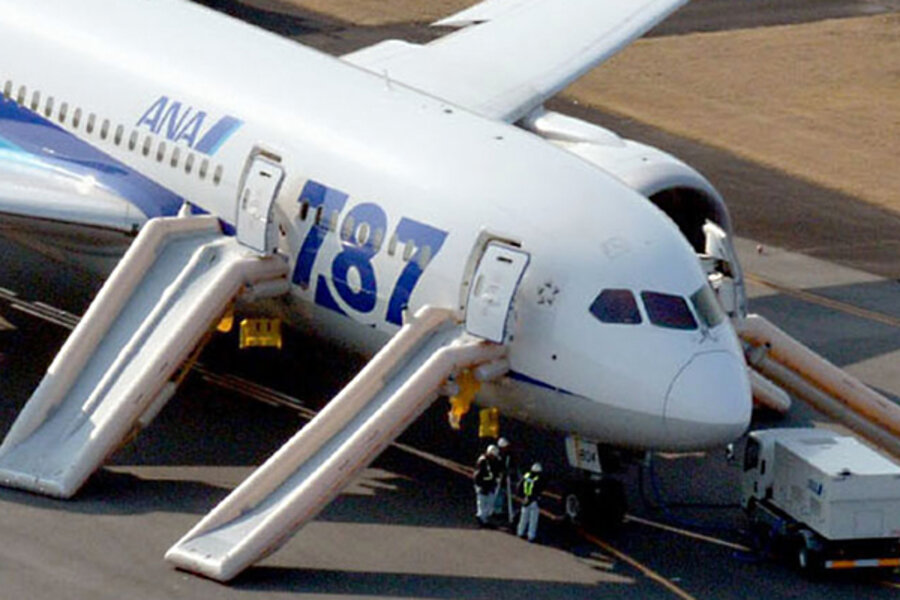Dreamliner makes emergency landing in Tokyo. Boeing 787 flights grounded.
Loading...
| Tokyo
Japan's two biggest airlines grounded all their Boeing 787 aircraft for safety checks Wednesday after one was forced to make an emergency landing in the latest blow for the new jet.
All Nippon Airways said a cockpit message showed battery problems and a burning smell was detected in the cockpit and the cabin, forcing the 787 on a domestic flight to land at Takamatsu airport in western Japan.
The 787, known as the Dreamliner, is Boeing's newest and most technologically advanced jet, and the company is counting heavily on its success. Since its launch, which came after delays of more than three years, the plane has been plagued by a series of problems including a battery fire and fuel leaks. Japan's ANA and Japan Airlines are major customers for the jet and among the first to fly it.
Japan's transport ministry said it received notices from ANA, which operates 17 of the jets, and Japan Airlines, which has seven, that all their 787s would not be flying. The grounding was done voluntarily by the airlines.
The earliest manufactured jets of any new aircraft usually have problems and airlines run higher risks in flying them first, said Brendan Sobie, Singapore-based chief analyst at CAPA-Center for Aviation. Since about half the 787 fleet is in Japan, more problems are cropping up there.
"There are always teething problems with new aircraft and airlines often are reluctant to be the launch customer of any new airplanes," Sobie said. "We saw it with other airplane types, like the A380 but the issues with the A380 were different," he said.
Japan's transport ministry categorized Wednesday's problem as a "serious incident" that could have led to an accident, and sent officials for further checks to Takamatsu airport. The airport was closed.
It was unclear how long the Dreamliners would remain grounded. ANA said 14 flights were changed to other aircraft, while 31 domestic and seven international were canceled. JAL said eight were canceled, while two were changed to a Boeing 777.
ANA executives apologized, bowing deeply at a hastily called news conference in Tokyo.
"We are very sorry to have caused passengers and their family members so much concern," said ANA Senior Executive Vice President Osamu Shinobe.
One male in his 60s was taken to the hospital for minor hip injuries after going down an emergency slide from the aircraft, the fire department said. The other 128 passengers and eight crew members were uninjured, according to ANA.
The grounding in Japan was the first for the 787, whose problems had been brushed off by Boeing as teething pains for a new aircraft. The transport ministry had already started a separate inspection Monday of another 787 jet, operated by Japan Airlines, which had leaked fuel at Tokyo's Narita airport after flying back from Boston, where it had also leaked fuel.
A fire ignited Jan. 7 in the battery pack of an auxiliary power unit of a Japan Airlines 787 empty of passengers as the plane sat on the tarmac at Boston's Logan International Airport. It took firefighters 40 minutes to put out the blaze.
ANA canceled a domestic flight to Tokyo on Jan. 9 after a computer wrongly indicated there was a problem with the Boeing 787's brakes. Two days later, the carrier reported two new cases of problems with the aircraft — a minor fuel leak and a cracked windscreen in a cockpit.
The 787 relies more than any other modern airliner on electrical signals to help power nearly everything the plane does. It's also the first Boeing plane to use rechargeable lithium ion batteries, which charge faster and can be molded to space-saving shapes compared to other airplane batteries. The plane is made with lightweight composite materials instead of aluminum.
The U.S. Federal Aviation Administration said in a statement that it is "monitoring a preliminary report of an incident in Japan earlier today involving a Boeing 787."
It said the incident will be included in the comprehensive review the FAA began last week of the 787 critical systems, including design, manufacture and assembly. U.S. government officials have been quick to say that the plane is safe. Nearly 50 of them are in the skies now.
GS Yuasa Corp., the Japanese company that supplies all the lithium ion batteries for the 787, had no comment as the investigation was still ongoing. Thales, which makes the battery charging system, had no immediate comment.
In Tokyo, the transport minister, Akihiro Ota, said authorities were taking the incidents seriously.
"These problems must be fully investigated," he said.
Boeing has said that various technical problems are to be expected in the early days of any aircraft model.
"Boeing is aware of the diversion of a 787 operated by ANA to Takamatsu in western Japan. We will be working with our customer and the appropriate regulatory agencies," Boeing spokesman Marc Birtel said.
The U.S. National Transportation Safety Board is aware of Wednesday's emergency landing in Japan and is gathering information on the incident, said Kelly Nantel, a spokeswoman for the board.
In Wednesday's incident, a cockpit instrument showed a problem with the 787's battery and the pilot noticed an unusual smell, the airline said. The flight requested and was granted permission to make an emergency landing at Takamatsu airport.
Aviation safety expert John Goglia, a former National Transportation Safety Board member, said the ANA pilot made the right decision.
"They were being very prudent in making the emergency landing even though there's been no information released so far that indicates any of these issues are related," he said.
But much remains uncertain about the problems being experienced by the 787, said Masaharu Hirokane, analyst at Nomura Securities Co. in Tokyo.
"You need to ensure safety 100 percent, and then you also have to get people to feel that the jet is 100 percent safe," Hirokane said.







